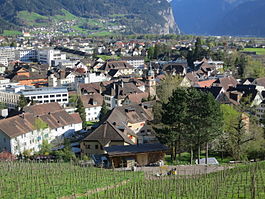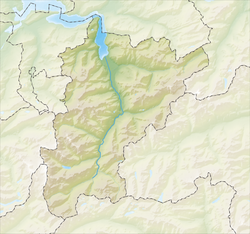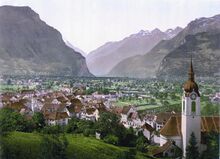Place:Altdorf, Uri
Altdorf | |
|---|---|
 | |
| Coordinates: [ ⚑ ] : Template:Swiss populations data CH-UR) 46°52′N 8°38′E / 46.867°N 8.633°E | |
| Country | Switzerland |
| Canton | Uri |
| District | n.a. |
| Government | |
| • Executive | Gemeinderat with 7 members |
| • Mayor | Gemeindepräsident/in Urs Kälin SPS/PSS |
| • Parliament | none (Gemeindeversammlung) |
| Area | |
| • Total | 10.21 km2 (3.94 sq mi) |
| Elevation (Church St. Martin) | 458 m (1,503 ft) |
| Highest elevation (Eggberge) | 1,720 m (5,640 ft) |
| Lowest elevation (Wildried) | 432 m (1,417 ft) |
| Population | |
| • Total | Template:Swiss populations data CH-UR |
| Demonym(s) | German: Altdorfer(in) |
| Time zone | UTC+01:00 (Central European Time) |
| • Summer (DST) | UTC+02:00 (Central European Summer Time) |
| Postal code(s) | 6460 |
| SFOS number | 1201 |
| Surrounded by | Attinghausen, Bürglen, Flüelen, Seedorf |
| Twin towns | Altdorf b. Nürnberg (Germany) |
| Website | altdorf SFSO statistics |
Altdorf is a municipality in Switzerland. It is the capital of the Swiss canton of Uri and retains historic town privileges. It is the place where, according to the legend, William Tell shot the apple from his son's head.[1]
Aldorf is situated on the right (eastern) bank of the Reuss, about 2 kilometres (1.2 mi) south of where the river discharges into the Urnersee, an arm of Lake Lucerne. It is at the junction of two major Alpine passes—Saint Gotthard to the south and the Klausen Pass to the east—and is the last station on the Gotthard railway before the line enters the Gotthard Base Tunnel, the world's longest railway tunnel.
The official language of Altdorf is Swiss Standard German, but the main spoken language is the local variant of the Alemannic dialect.
Geography
File:ETH-BIB-Altdorf aus 400 m-Inlandflüge-LBS MH01-002946.tif The municipality covers an area of 10.21 square kilometres (3.94 sq mi). The town proper[note 1] sits at an altitude of 458 metres (1,503 ft) above sea level on a flat alluvial plain between the right bank of the river Reuss and the steep hillside of the Rossstock 2.4 km (1.5 mi) to the east. The scattered hamlets and pastureland of Eggbergen, about 1,000 metres (3,300 ft) above the town, also belong to the municipality.
Of Altdorf's total area, about 36% is used for agricultural purposes (predominately for orchards or vineyards), 37–39% is forested, 23% is settled (buildings or roads) and the remainder is rivers, glaciers, or mountains.[2][3]
Altdorf adjoins the municipalities of Attinghausen and Seedorf across the Reuss to the west, Flüelen, the port village at the Urnersee to the north, Bürglen in the Schächental to the east and south, and Schattdorf to the south.
History
The earliest evidence of a settlement in Altdorf are several La Tène era bronze ax-heads and iron tools from the 3rd century BCE. The people that settled in this region initially settled in the forest, and expanded toward the banks of the Reuss. When the Reuss periodically flooded, the low lying settlements were destroyed and the inhabitants were driven back to the "old town", a possible source of the name Altdorf.[4]
Following the collapse of the Roman Empire the local Gallo-Roman population of Altdorf began to mix with the Germanic Alamanni during the 7th century. The earliest evidence of this is the grave of an armed horseman (dated to 670–680) located in the local St Martin's Church.[5]
The current town was first mentioned in 1223 as Alttorf, whereas some sources from the 16th to 19th centuries occasionally refer to it as Uri.[6]
Demographics
Altdorf has a population (as of Template:Swiss populations date) of Template:Swiss populations data CH-UR.Template:Swiss populations data CH-UR As of 2017, 1,347 people or 14.8% of the population was made up of foreign nationals.[7] From 2008 through 2017 the population has increased at an annual rate of 0.8%.[8] Most of the population ((As of 2000)) speaks German (88.3%), with Serbo-Croatian being second most common (4.2%) and Italian being third ( 2.5%).[2] (As of 2007) the gender distribution of the population was 48.4% male and 51.6% female.[9]
In Altdorf about 65.2% of the population (between age 25–64) have completed either non-mandatory upper secondary education or additional higher education (either university or a Fachhochschule).[2]
Altdorf has an unemployment rate of 1.45%. (As of 2005), there were 137 people employed in the primary economic sector and about 49 businesses involved in this sector. 1,748 people are employed in the secondary sector and there are 77 businesses in this sector. 3,585 people are employed in the tertiary sector, with 403 businesses in this sector.[2]
Historical population
| year | population | Swiss citizens | % German Speaking | % Roman Catholic |
|---|---|---|---|---|
| 1600 | c. 3,100 | |||
| 1629 | c. 1,500 | |||
| 1650 | c. 3,000 | |||
| 1743 | 3,025 | |||
| 1799 | c. 2,000 | |||
| 1837 | 1,903 | |||
| 1850 | 2,112 | 2,088 | ||
| 1880 | 2,906 | 2,734 | 97.9% | 96.0% |
| 1910 | 3,854 | 3,515 | 94.2% | 93.6% |
| 1930 | 4,240 | 3,984 | 94.7% | 92.0% |
| 1950 | 6,576 | 6,236 | 94.5% | 88.7% |
| 1970 | 8,647 | 7,659 | 89.7% | 89.4% |
| 1990 | 8,282 | 7,158 | 88.0% | 84.3% |
source:[6]
Sights
Tell Monument
According to the legend, Altdorf's marketplace is the site where William Tell shot the apple from his son's head,[1] and in 1895 sculptor Richard Kissling unveiled a bronze statue commemorating the feat at the foot of an old tower.[10]
In 1899 a theatre was opened close to the town's center for the purpose of performing Schiller's play of Wilhelm Tell.
Historisches Museum and the Haus für Kunst Uri
In 1905 a Museum was opened on Gottardstrasse just south of the centre of the town that houses a collection of local antiquities, weapons and regional furniture, as well as a collection of portraits of important Uri citizens, including fine ones by the Andermatt-born Felix Maria Diogg (1762–1834). There are several paintings here by the Swiss-born American artist Adolfo Müller-Ury (1862–1947) whose family came from Hospental, including portraits of Pope Pius X, Pope Pius XI, Cardinal Merry del Val, the artist's father Alois Muller, his uncle Domherr Josef Muller, and a large allegorical work Alpenrose und Edelweiss. The museum was extended in the 1990s.
Recently the town has established the Haus für Kunst Uri at Herrengasse 2 in a partly converted historic house with a large contemporary extension creating an attractive exhibition space. The work of Swiss and international contemporary artists from Uri is exhibited here, and they sometimes have exhibitions of earlier historical art.
Climate
Between 1961 and 1990 Altdorf had an average of 133.7 days of rain per year and on average received 1,099 mm (43.3 in) of precipitation. The wettest month was August during which time Altdorf received an average of 135 mm (5.3 in) of precipitation. During this month there was precipitation for an average of 13.2 days. The month with the most days of precipitation was June, with an average of 14.4, but with only 127 mm (5.0 in) of precipitation. The driest month of the year was February with an average of 66 mm (2.6 in) of precipitation over 13.2 days.[11] According to the Köppen Climate Classification system, Altdorf is classified as Cfb, or Marine West Coast Climate.[12]
Script error: No such module "weather box".
International relations
Twin towns – sister cities
Altdorf is twinned with:
Transport
Altdorf is served by the regional public transport hub of Altdorf railway station, situated within the municipality and on the Gotthard railway. In 1899 a carriage-road was opened from Altdorf through the Schächental and over the Klausen Pass (1,948 metres (6,391 ft)) to the village of Linthal (46 kilometres (29 mi)) and so to Glarus.[14] In 1906, the Altdorf–Flüelen tramway was constructed to connect the centre of Altdorf with Fluelen railway station.[15] The electric tramway operated until 1951, when it was replaced by a bus service.[16]
Notable people
- Sebastian Peregrin Zwyer (1597–1661) was a Swiss military commander, mercenary entrepreneur, and one of the foremost politicians of the Old Swiss Confederacy; died in Altdorf
- Henry Haller (born 1923 in Altdorf, Uri) a retired Chef who served as Executive Chef at the White House for 22 years
- Beat Streuli (born 1957 in Altdorf, Uri) a Swiss visual artist who works with photo and video based media
- Luzia Zberg (born 1970 in Altdorf, Uri) a retired racing cyclist
- Beat Zberg (born 1971 in Altdorf, Uri) a Swiss former professional road bicycle racer
- Matthias Simmen (born 1972 in Altdorf, Uri) a retired Swiss biathlete, he competed in the 2002, 2006 and 2010 Winter Olympics
- Markus Zberg (born 1974 in Altdorf, Uri) a retired Swiss professional road bicycle racer
See also
- List of towns in Switzerland
- List of municipalities of Switzerland
- Municipalities of the canton of Uri
Notes and references
Notes
References
- ↑ 1.0 1.1 "Die Sage von Wilhelm Tell, Schweizer Freiheitsheld". http://www.wilhelm-tell.geschichte-schweiz.ch/.
- ↑ 2.0 2.1 2.2 2.3 Swiss Federal Statistical Office accessed 8 September 2009
- ↑ Canton Uri – Ground use statistics (in German) accessed 8 September 2009
- ↑ Altdorf website-History-First Settlement accessed 22 November 2008 (in German)
- ↑ Template:HLS
- ↑ 6.0 6.1 Altdorf (UR) in German, French and Italian in the online Historical Dictionary of Switzerland.
- ↑ "Ständige ausländische Wohnbevölkerung, 2017". Federal Statistical Office (Switzerland). https://www.atlas.bfs.admin.ch/maps/13/de/13559_90_89_70/21857.html.
- ↑ "Bevölkerung der Urner Gemeinden und Regionen". Canton of Uri. https://www.ur.ch/_docn/160477/2017_Bevoelkerung_Gem_08-17.pdf.
- ↑ Uri Population statistics (in German) accessed 8 September 2009
- ↑ Horat, Karl (4 September 2019). "Die Verbannung des «bleichen Tell» aus Altdorf" (in de). https://www.luzernerzeitung.ch/zentralschweiz/uri/die-verbannung-des-bleichen-tell-ld.1148705.
- ↑ "Temperature and Precipitation Average Values-Table, 1961–1990" (in de, fr, it). Federal Office of Meteorology and Climatology – MeteoSwiss. http://www.meteoswiss.admin.ch/home/climate/past/climate-normals/normal-values-per-measured-parameter.html., the weather station elevation is 438 metres (1,437 ft) above sea level.
- ↑ "Altdorf, Switzerland". Great Falls, VI, USA: CantyMedia, Canty and Associates LLC. n.d.. http://www.weatherbase.com/weather/weather-summary.php3?s=590603&cityname=Altdorf%2C+Uri%2C+Switzerland&units=.
- ↑ "Climate Normals Altdorf (Reference period 1991−2020)". Swiss Federal Office of Meteorology and Climatology, MeteoSwiss. https://www.meteoswiss.admin.ch/product/output/climate-data/climate-diagrams-normal-values-station-processing/ALT/climsheet_ALT_np9120_e.pdf.
- ↑
 One or more of the preceding sentences incorporates text from a publication now in the public domain: Coolidge, William Augustus Brevoort (1911). "Altdorf". in Chisholm, Hugh. Encyclopædia Britannica. 1 (11th ed.). Cambridge University Press. p. 763.
One or more of the preceding sentences incorporates text from a publication now in the public domain: Coolidge, William Augustus Brevoort (1911). "Altdorf". in Chisholm, Hugh. Encyclopædia Britannica. 1 (11th ed.). Cambridge University Press. p. 763.
- ↑ Waldis, Alfred (2002). Es begann am Gotthard. Lucerne: Maihof Verlag. pp. 78. ISBN 3-95220335-1.
- ↑ Jürg Ehrbar. "Altdorf–Flüelen – Rigi–Scheidegg Bahn" (in de). eingestellte-bahnen.ch. Zweisimmen, Switzerland: Jürg Ehrbar. http://www.eingestellte-bahnen.ch/636/19743.html.
External links
- (in German) Official website
 |







